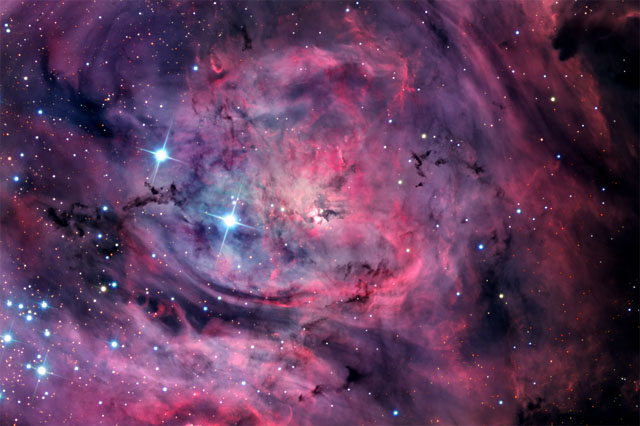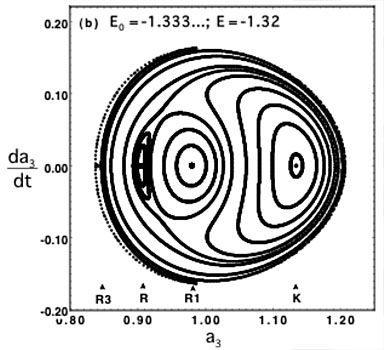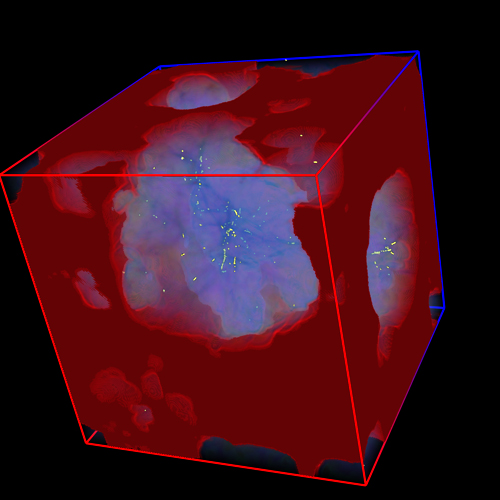 |
 |
 |
 |
 |
 |
 |
 |
 |
 |
 |
 |
|
Talks & Events
|
Faculty Research Seminars: 2015
Hunting for Dark Matter Although dark matter seems very likely to be made up of some new variety (or varieties) of particle, the detection of these particles has been elusive. That being said, we are currently in a very data rich period, allowing us to test an unprecedented fraction of proposed dark matter models. We'll discuss the main techniques being pursued to test the WIMP hypothesis, and assess the current state and future of research in dark matter. A new perspective on the diffuse interstellar bands A fifteen year survey of the unidentified diffuse interstellar bands (DIBs) has been carried out at Apache point observatory using an echelle spectrograph with a resolving power of ~35,000. The wavelengths explored include the region 3700A to 8500A, so we have a large amount of complementary data on optical interstellar (identified lines) and diatomic molecules. We have a) confirmed that the strongest DIBs do not relate to molecular hydrogen and seem to exist mainly at the surface of diffuse clouds, not in their interiors; b) discovered a new, small class of DIBs that seem to exist below the surface of clouds but still to exist in the diffuse molecular part of the clouds; c) discovered evidence that the profiles can be slightly modified in the presence of a high IR radiation field (IR pumping); d) used this fact to formulate a new view that the DIBs are small molecules (not yet observed in the lab) containing only 5-7 atoms in some cases; e) enhanced the argument that the DIBs are ubiquitous in the Universe and represent a major puzzle relating to all aspects of the nature of the interstellar medium (grains, star formation, chemistry). The Virial Equations, Stellar Pulsations, and the Beta Canis Majoris Stars The virial equations and the virial theorem are well known tools of inquiry in dynamical astronomy. However, astronomers seldom appreciate the full power of the tensor virial equations in theoretical investigations of the non-linear oscillations of stars and stellar systems. After a brief review of the history of the virial equations and of conventional astronomical applications, we devote most of the seminar to applications of the virial equations to studies of stellar pulsations of the kind pioneered by Paul Ledoux, S. Chandrasekhar, and Norman Lebovitz. In particular, we concentrate on a proposal by Chandrasekhar and Lebovitz that an accidental degeneracy of the fundamental mode of radial pulsation and the lowest non-radial mode of pulsation in a spherical star underlies the beat phenomenon observed in the pulsations of the Beta Canis Majoris stars. The degeneracy of the two modes of infinitesimal pulsation must manifest itself as a resonance in the non-linear pulsations of such stars. We have investigated that resonance with the aid of a model of the non-linear pulsations governed by the tensor virial equations and an equation governing the variations of the internal energy of the star. The system of governing equations is closed with the aid of a model of the density distribution and internal motions in the star. The governing equations admit of a Hamiltonian formulation. Accordingly, we investigate the pulsations of the model with the aid of standard methods in the study of dynamical systems. An essential result is that the beat phenomenon envisaged by Chandrasakhar and Lebovitz for the Beta Canis Majoris stars is an essentially non-linear phenomenon. Finding and Destabilizing Circumbinary Planets Secular Chaos "Shaping the Architectures of Old Planetary Systems" Strong Lensing: An Observational Perspective Strong lensing is one of the most striking observed phenomenon in the Universe, producing remarkably magnified and disorted images of distant galaxies and quasars that give us unique insight into both the massive intervening lenses, and the lensed sources. I will give an overview of work by my group in Chicago on both finding large samples of strong lenses - in the SPT, SDSS, and elsewhere - and the scientific exploitation of those samples. The discussion will include a brief glimpse of recent work on realistic simulations of strong lensing undertaken in collaboration with scientists at Argonne. Image: Discovery images of 6 new SPT strong lenses recently found using the PISCO imager on Magellan. Cosmic Reionization On Computers I will review the field of numerical simulations of cosmic reionization: the process of ionizing of intergalactic medium by high redshift galaxies and quasars. I will describe the main physical processes that are important for modeling reionization, explain how these processes are incorporated in computer simulations, and will use simulations to gain insight into the actual reionization process. I will finish with an illustration of how the exponential increase in the computing power allows us to solve problems that we could not even dream about mere 10 years ago. |






